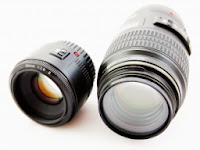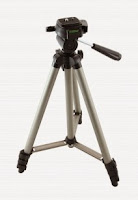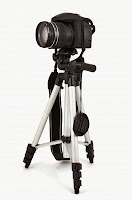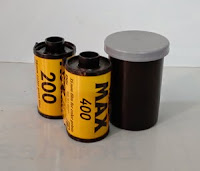 |
Lens of Digital SLR Camera
(Image courtesy of mapichai
at FreeDigitalPhotos.net)
|
When we use our camera to capture a moment, it is the light which travels into the camera through the lens and reaches the
Sensor which then converts the light into an electronic signal and the amount of light that enters into the camera
is called
Exposure. It is the most important part of good photography to decide how much amount of outside light is required to enter through the lens & reach the Sensor and to do that we need to know about three factors that determines the amount of light to enter into the camera and they are
Aperture,
Shutter Speed &
ISO.
APERTURE : In every camera, there is a lens and inside every lens there is a opening through which light travels into the camera & reaches the Sensor and that opening is called
Aperture. In other words, Aperture is the
opening inside the lens which determines how much light reaches the Sensor, i.e. smaller the opening, less light gets
into the sensor and bigger the opening, more light gets into the sensor. To control the opening of the lens or the size of Aperture, we need to understand the concept of F-stops in a camera.
 |
Aperture Opening inside Lens of a Digital SLR Camera
(Image courtesy of suphakit73 at FreeDigitalPhotos.net)
|
F-stops can be mathematically defined as the ratio of Focal Length and Diameter of the Aperture, where
Focal Length is the length between the Sensor & the Lens of a camera and Diameter of the Aperture is the diameter of the opening of the lens in a camera. E.g. If the Focal Length in a camera is 16mm & Diameter of the Aperture is 4mm, then F-stops is Focal Length / Diameter of the Aperture, i.e. 16 / 4 = 4, and the answer is f/4. Lets take another example, where Focal Length is same as above i.e.16 mm and Diameter of the Aperture is smaller than the above i.e. 2 mm, so now the F-stops is 16 / 2 = 8, i.e. f/8. So we have seen that there is a relationship between size of Aperture & F-stops, i.e. bigger the F-stops value, smaller the size of Aperture. Lets take another example, where Focal Length is same as above, i.e. 16mm and Diameter of the Aperture is bigger than the above, i.e. 8mm, so now F-stops is 16 / 8 = 2, i.e. f/2, which proves that smaller the F-stops value, bigger the size of Aperture. So now it is clear that F-stops controls the size of Aperture in a camera. In other words, we can control the size of Aperture by changing the F-stops in a camera.
SHUTTER SPEED : Inside every camera there is a shutter, present infront of Sensor, which acts as a door that opens & allows light to come into the sensor at the time of taking picture and it closes again. We can control how long the shutter remains open to allow more light to get into the sensor & then it closes. This span of time the shutter remains open is called
Shutter Speed. Along with Aperture, Shutter Speed is the another factor that determines the amount of light to enter into the camera & reach the sensor. The Shutter Speed is measured in seconds or fractions of seconds. Almost every digital camera may have Shutter Speeds like 30 sec, 15 sec, 8 sec, 4 sec, 2 sec, 1 sec, 1/2 sec, 1/4 sec, 1/8 sec, 1/15 sec, 1/30 sec, 1/60 sec, 1/125 sec, 1/250 sec, 1/500 sec & 1/1000 sec, where 30 second duration is the Slower Shutter Speed & 1/1000 second or 1/1000 of a second duration is the Faster Shutter Speed. The more time the shutter remains open, the more light enters into the sensor and the less time the shutter remains open, the less light enters into the sensor. In other words, if the shutter opens & closes very fast like shutter speed of 1/1000 sec, then the sensor is not getting much time to get exposed to light and hence less light reaches the sensor. On the other hand, if the shutter opens & remains open for some time & closes like shutter speed of 30 sec, then the sensor is getting some time to get exposed to light and hence more light reaches the sensor. Now a question may arise that why & when we need to use slower shutter speed as well as faster shutter speed.
Mostly, while taking a picture, we hold the camera in our hand, so it is better to set the shutter speed at 1/60 sec or faster. Suppose, if we set the shutter speed at slower than 1/60 sec, then there is a chance of camera shake
 |
Tripod without Camera
(Image courtesy of Keerati
at FreeDigitalPhotos.net)
|
 |
Tripod with Camera
(Image courtesy of furuoda
at FreeDigitalPhotos.net)
|
and as a result it may not give the sharp picture that we are looking for, so in such a situation we need to use a
Tripod, instead of holding the camera in our hand. But, there are many individuals who can hold the camera more steadily than others, still it is better to use a Tripod to get best results. On the other hand, during day time we have lots of light available so if we want to take picture of a moving object, either a flying bird or a moving car, we need to use faster shutter speed to get sharp picture of that moving object i.e. faster the moving object, faster the shutter speed we have to set, otherwise the moving object will look blurry in the picture if we use slower shutter speed in such a situation. Similarly, when we take outdoor pictures at night we have less light available, so we need to use slower shutter speed to allow the shutter to remain open for some time to grab more light from all around and we need to use a Tripod in such a situation. So, depending on the situation, we have to control the shutter speed to allow the required amount of light to enter & reach the sensor to get best result.
 |
ISO Ratings in 35mm Roll Films
(Image courtesy of myownphotography at
basicknowledgeondigitalphotography.blogspot.in)
|
ISO : Those who know about Roll Film photography will be able to remember that during our childhood days we were more familiar with Roll Film Cameras and for taking photos we used to buy 35mm Photographic Roll Films of different numbers written on the them like 100 or 200 or 400 and we used to select them according to the required number. Actually those numbers are nothing but
ISO ratings, which means how sensitive that Roll Film is to light i.e. how much light that Roll Film is able to accept. So the same concept also applies here in the case of Digital Camera where we have Sensor, instead of a Roll Film and in this case, ISO ratings are like 100 - 200 - 400 - 800 - 1600 - 3200 & even 6400 depending on the type of digital camera, so here ISO refers to how sensitive our Sensor is to light. In other words, the lower the ISO, the less sensitive our sensor is to light (e.g. during the day time we have lots of light available & we do not need any artificial light, so the sensor is less sensitive to light & we need to use lower ISO) and the higher the ISO, the more sensitive our sensor is to light (e.g. during the night time or in any low light situation we need to use higher ISO as the sensor is more sensitive to light and in such situation we have very less light available so whatever light is available, sensor gathers all the light & creates an artificial light that enables to get the correct exposure). So, now it is clear that, along with Aperture & Shutter Speed, ISO is also another factor that plays a very important role in determining exposure and we, always, need to keep all the three, i.e. Aperture, Shutter Speed & ISO, in mind while taking a picture.





No comments:
Post a Comment